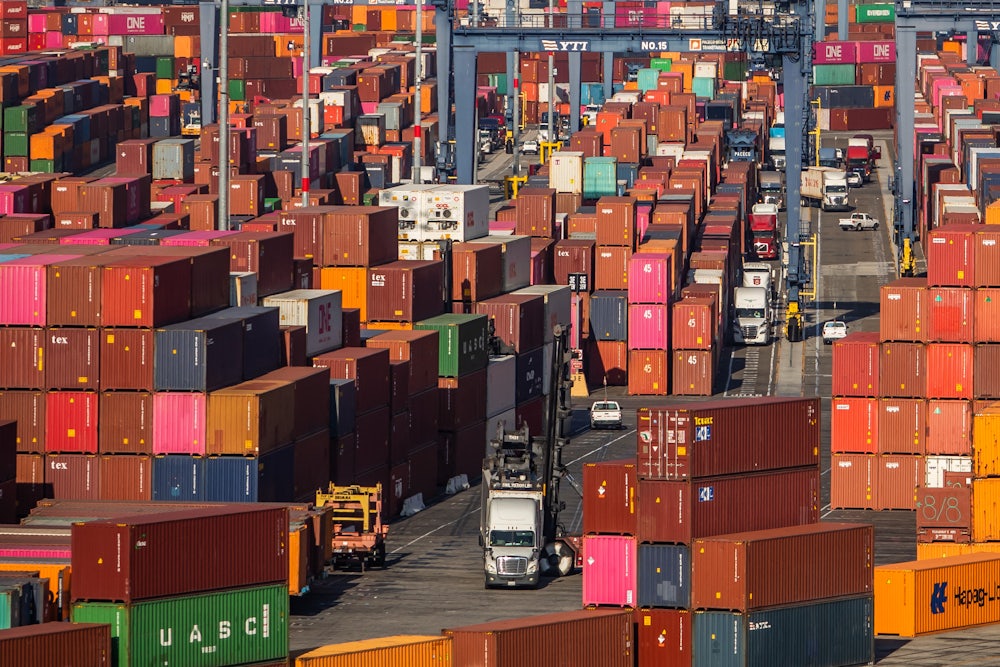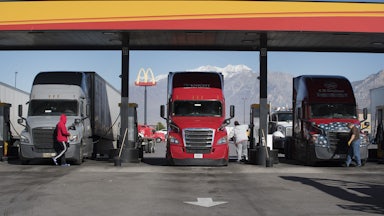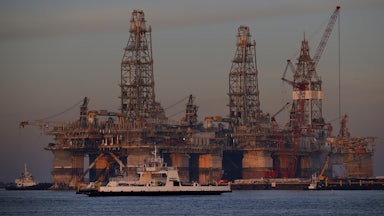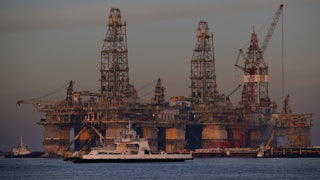In the United States—where just acknowledging the existence of climate change has been enough for companies to earn kudos from liberals—the fact that the major institutions of capital now appear to be taking rising temperatures more seriously than before can seem like a reason for optimism. But these seeming-blessings may not be broadly shared. Yes, business leaders and major firms are acknowledging the climate crisis and its impacts. That doesn’t necessarily portend good news for the planet.
For instance, industry reports on climate change that typically look at the risks worsening weather and rising seas pose to supply chains tend to pointedly eschew the many ways supply chains themselves fuel this cycle of deterioration. Like the airline industry, the shipping industry is officially excluded from the Paris Agreement, its emissions ostensibly governed by a secretive U.N. agency comprised of logistics industry veterans.
The recent pandemic-induced hype-cycle fueling news stories about supply chain trouble has tended to focus on troubles at ports. But the freighters and hulking, multicolor containers that these reports evoke are just one link in any one company’s supply chain and the emissions they generate. Climate change is indeed a grave threat to port infrastructure, but the wine or khakis transiting through them face deeper challenges than trucking and ship queues, much of which is understated by traditional economic modeling on climate change. From scalding fields and unair-conditioned warehouses in the Pacific Northwest heatwave this past summer to flooding in China that knocked out coal-fired power plants in the fall, climate change is already putting pressure on sprawling supply chains engineered over decades to operate on the thinnest of margins. These strains will only grow as temperatures rise.
But there’s a pattern to how major sectors of the economy are addressing these threats. The U.S. military—perhaps the world’s largest public-private partnership, with its own extensive supply chains—has published exhaustive reports about climate change for well over a decade. Its efforts, however, are primarily focused on the risks that floods, fires, and other disasters pose to defense operations around the world, from bases to training activities.
That’s the thrust of the craze around Environmental, Social, and Governance investing, or ESG, as well: It’s principally a means for banks and asset managers to assess various risks to their portfolios while bolstering their reputations, accounting for climate policies that might tank fossil fuel stock values or real estate holdings which could be underwater soon. While there’s been a growing interest in climate-related financial regulation, including from the White House, even that is still mostly limited to making companies disclose the risks that climate change poses to financial institutions, not the effects of the projects they finance on the atmosphere.
The trouble is in conflating self-interested risk assessment with a plan for reducing emissions within what are in some cases fabulously carbon-intensive industries. If they formed a country, the world’s 18 largest banks and asset managers would be the world’s fifth-largest emitter, according to a study from the Center for American Progress and the Sierra Club. In the five years after the Paris Agreement was first brokered in 2015, major banks now cashing-in on sustainable investment trends have financed $3.8 trillion worth of fossil fuel projects. Just eight supply chains—for fashion, automobiles, electronics, construction, food, freight, “fast-moving consumer goods,” and professional services, including consultants—account for half of greenhouse gas emissions. The bulk of those emissions aren’t produced in final manufacturing (say, assembling a car), but are embedded in agriculture, source materials, and shipping that typically fall under the purview of several different contractors and subcontractors that rarely share emissions data with one another.
The U.S. military is the world’s single largest institutional emitter of fossil fuels and the federal government’s biggest consumer of fossil fuels. Conveniently, it was also excluded from the White House’s recent executive order mandating the federal government work toward net-zero goals. And just a handful of countries have opted to include military emissions in their nationally determined contributions to the Paris Agreement; they’re voluntary under that pact. So the gargantuan, $768 billion National Defense Authorization Act for Fiscal Year 2022 that passed with broad bipartisan support in the House and Senate, and which President Biden signed this week, could carry a carbon footprint larger than a slashed version of Build Back Better might ever hope to cancel out. As The Boston Globe’s Dharna Noor reported, the only climate provision included in the defense budget is one requiring the Defense Department to submit annual reports on how it intends to reduce greenhouse gas emissions.
The sectors most critical to the climate fight are also those most central to the functioning of the global economy. Through a combination of political expedience and economic necessity, carve-outs exclude the very industries whose emissions need to be most drastically reduced. More often than not, their voluntary responses to cutting carbon don’t examine the ways they’re actively fueling the crisis: Airline and shipping, for instance, have each leaned heavily on carbon offsets. Finance has trumpeted its token green funds while continuing to invest in fossil fuels, something that isn’t a problem considering the lack of rules around what fits under the widening ESG umbrella. The question is whether these critical sectors will be made to account for their contributions to the climate crisis or deemed too critical to have to make cuts after the current wave of supply chain–hype has subsided.










